04 Aug 2023
Combined Garmin Compatible Map
</! Categories were [OpenStreetMap, Cycling, Walking, Garmin-Maps, Canal] />
No longer being produced - message me if you would like me to resume producing it.
This extends to an area covering most of Great Britain, and within that area shows the routes of;
The Avenue Verte within GB,The North Downs Way walking route,The North Sea Cycle route within GB, andMany canal features, such as locks, bridge numbers & names, winding holes, and water points.

All mapping data is derived from OpenStreetMap, including the downloadable maps. Many thanks to OpenStreetMap contributors for their skill & dedication.
If you wish to contact me - feedback about any of these maps is always welcome, please do so through:
https://www.openstreetmap.org/user/Tallguy
03 Aug 2023
No longer being produced - March 2024

All mapping data is derived from OpenStreetMap, including the downloadable maps. Many thanks to OpenStreetMap contributors for their skill & dedication.
</! these are the categories that were in use [OpenStreetMap, Walking, Garmin-Maps] />
Link for all Downloads
All maps are available from
https://daphne-nick.uk/nextcloud/index.php/s/6cQesAz38DWRWBo
either as a direct download if the file is less than 500mb in size, or as a torrent link (it’s saved as a .7z because my nextcloud server will only handle it if it is zipped - extract it and then open with your torrent programme).
All dates {DATE} are in the format YYYYMMDD.
All maps also show the start position for Parkruns (where available).
These maps have been tested on:
- Garmin Edge 530 (no microSD card slot. The small file was copied to the internal memory - search on internet for ‘how’- at your own risk).
- Garmin Edge 810
- Garmin Edge Touring
- Garmin Edge 605 & 705
- Garmin Etrex 30
- Garmin Basecamp
- QMapShack
The maps are updated every month, depending on my availability.
You will need a torrent sharing programme on your computer, such as Transmission or Deluge (there are many, just search on the internet if you haven’t come across them before). There is a guide to installing maps onto your Garmin device here. If all of this sounds very complicated to you, and you just want to buy one of these maps already installed onto a microSD card, I do offer them for sale on ebay - listing links are with the map details below.
North Downs Way - Garmin compatible map
File name = north_downs_way_{DATE}.7z (These files are less than 50mb in size and are available as a direct download).
If you wish to contact me - feedback about any of these maps is always welcome, please do so through:
https://www.openstreetmap.org/user/Tallguy
02 Aug 2023
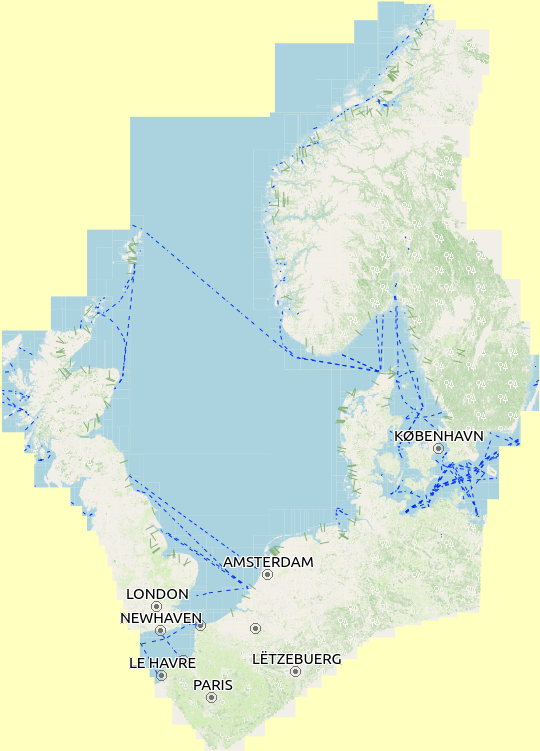
All mapping data is derived from OpenStreetMap, including the downloadable maps. Many thanks to OpenStreetMap contributors for their skill & dedication.
Downloads
The file needed for installation on a Garmin device, or for using in QMapShack (the .img file) is available as a direct download from https://daphne-nick.uk/nextcloud/index.php/s/iy8TkpoKCqcczqw
The .exe and .gmapi files are available via torrent downloads from https://daphne-nick.uk/nextcloud/index.php/s/6cQesAz38DWRWBo
All dates {DATE} are in the format YYYYMMDD.
All maps also show the start position for Parkruns (where available).
Tested on:
- Garmin Edge 530 (no microSD card slot. The small file was copied to the internal memory - search on internet for ‘how’- at your own risk).
- Garmin Edge 810
- Garmin Edge Touring
- Garmin Edge 605 & 705
- Garmin Etrex 30
- Garmin Basecamp
- QMapShack
The maps are updated every month, depending on my availability.
You will need a torrent sharing programme on your computer, such as Transmission or Deluge (there are many, just search on the internet if you haven’t come across them before). There is a guide to installing maps onto your Garmin device here. If all of this sounds very complicated to you, and you just want to buy one of these maps already installed onto a microSD card, I do offer them for sale on ebay - listing links are with the map details below.
If you wish to contact me - feedback about any of these maps is always welcome, please do so through:
https://www.openstreetmap.org/user/Tallguy
01 Aug 2023
All mapping data is derived from OpenStreetMap. Many thanks to OpenStreetMap contributors for their skill & dedication.
Downloads
There are two options available to you - the ‘small map’ which covers just the areas needed to complete the Avenue Verte cycle ride in France & GB, or the ‘large map’ which covers a much larger area of France & England.
All of the smaller files (.img, .exe, and .gmapi) are available from https://daphne-nick.uk/nextcloud/index.php/s/dQF4RD3eaA9fKCq
Only the larger .img file is available as a direct download, from https://daphne-nick.uk/nextcloud/index.php/s/EgsWzi2qoNYb2Q4 ,
with the remaining (.exe and .gmapi) files being available via torrent download, with the torrent files at https://daphne-nick.uk/nextcloud/index.php/s/6cQesAz38DWRWBo
All dates {DATE} are in the format YYYYMMDD.
All maps also show the start position for Parkruns (where available).
Garmin Compatible Avenue Verte Map
Navigation can get very complicated, and the Avenue Verte can be challenging to follow. These maps are intended to make your journey along this wonderful route much easier. This is a searchable and routable cycle / walking map with the following features;
- Broad Green Line visible on the map following the route of the Avenue Verte,
- On most devices, if you are on the Avenue Verte, the device will read “Riding on Ave Verte” (Garmin Edge 530 displays the name of the next road ahead).
- When you investigate the pretty village just off the route, it’s easy to see where the route is and navigate back to it,
- If you decide to load a gps track and follow that, the device will want to navigate you to the start of the track, even it that means going the ‘wrong-way’ - you don’t suffer from this problem,
- Other cycle routes are also shown, making it easier to follow alternative routes should you wish,
- When you are diverted off of the route (there are always diversions!), it is easier to choose where & how to rejoin the route,
- Icons show where to find toilets, drinking water, cycle shops, shops with cycle departments, cafe’s, restaurants, accomodation, supermarkets, convenience stores, food stores, pharmacies & hospitals.
- Start points of Parkruns are visible,
- Addresses are searchable
- As the device is not constantly recalculating your navigation, and using the backlight, your battery will last much longer (especially important on older devices where the battery is not as good as it once was).

Tested on:
- Garmin Edge 530 (no microSD card slot. The small file was copied to the internal memory - search on internet for ‘how’- at your own risk).
- Garmin Edge 810
- Garmin Edge Touring
- Garmin Edge 605 & 705
- Garmin Etrex 30
- Garmin Basecamp
- QMapShack
The maps are updated every month, often more often, depending on my availability.

You will need a torrent sharing programme on your computer, such as Transmission or Deluge (there are many, just search on the internet if you haven’t come across them before). There is a guide to installing maps onto your Garmin device here. If all of this sounds very complicated to you, and you just want to buy one of these maps already installed onto a microSD card, I do offer them for sale on ebay - listing links are with the map details below.
Small Map of the Avenue Verte (ave_verte_{date}.7z)
This map covers a slightly larger area than the Avenue Verte itself, and the file size is quite small - ideal for copying to the maps folder on one of the Garmin Edge devices that do not use a microSD card. The download is about 240mb, and when uncompressed you will have an ‘.img’ file, and a ‘.tdb’ file, so you can view the file using Garmin’s basecamp software.

Link to the Small_Ave_Verte on eBay.
Large Map of the Avenue Verte (ave_verte_w_europe_{date}.7z.torrent.7z)
File name = ave_verte_w_europe_{DATE}.7z.torrent.7z (These files are about 1.5GB in size and are available as a torrent from my nextcloud server).
Much larger area and file size - close to the maximum that can be used on a microSD card. Garmin devices require the microSD card is formatted as FAT16 or FAT32, and the largest file size they can deal with is 4GB. All of the same features that the small map has, but covers a much larger area.

Link to the Large Ave_Verte on eBay
If you wish to contact me - feedback about any of these maps is always welcome, please do so through:
https://www.openstreetmap.org/user/Tallguy
01 Jul 2023
Avenue Verte
The Avenue Verte is a mainly off-road cycle route extending from London to Paris. Depending on your choice of route, you can expect to cover at least 300 miles over the whole route. Much of the route is on old railway lines that have been transformed into very good cycle routes. There is a choice of routes in France.
Daphne & I have known of the route for several years, and were delighted to see a French friend who cycled with her electric bike the whole route, using friends or bed & breakfasts for accomodation.
In 2023 we decided to explore the French part of the route with friends. We have a car & caravan, and they have a motorhome. When cycling we look a little strange, as my cycle is a recumbent trike.

The route has it’s own very handy website at https://www.avenuevertelondonparis.co.uk/.
As is usual for us, the “Avenue Verte” became a long term theme. It allows us to have more than one holiday based around it, and we can dip in and out as it suits us.
We decided on 4 weeks in France, with roughly 3 weeks devoted to the Avenue Verte, and one week exploring the Honfleur area. The English section could follow later, but in truth Daphne & I have cycled most of it in previous years.
A Night near Newhaven
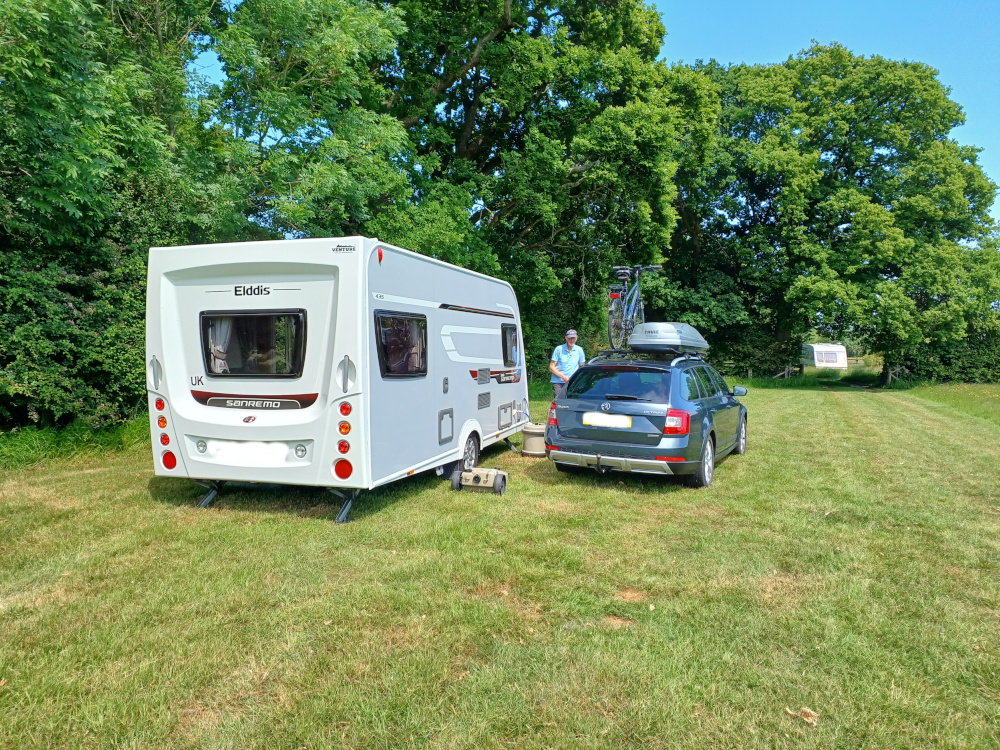
June 2023 saw us set-off with our caravan for a small site near Newhaven, which was ideal - nicely tucked away, and with a short walk available in the grounds to a beautiful nature pond. The site was fairly close to the ferry terminal, so we didn’t have to worry about a long journey in the morning. A fish & chips evening meal with our friends made a terrific start to the holiday.
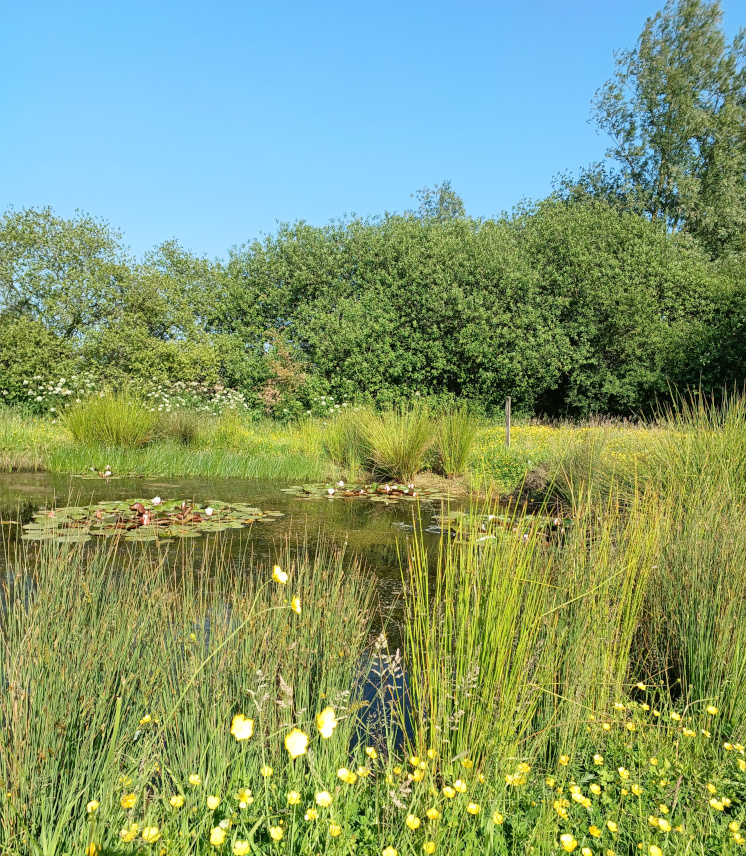
The early morning ferry Newhaven » Dieppe was a new one to us - quite pleasant really as there was enough time for a meal and an explore of the boat.
First Nights in France - Dieppe
A short drive from the ferry port and we were at our first campsite with a fishing lake and two rivers. All the facilities we needed to allow us to acclimatise, and the Avenue Verte running past the back of ths site within a few metres of an entrance - ideal!
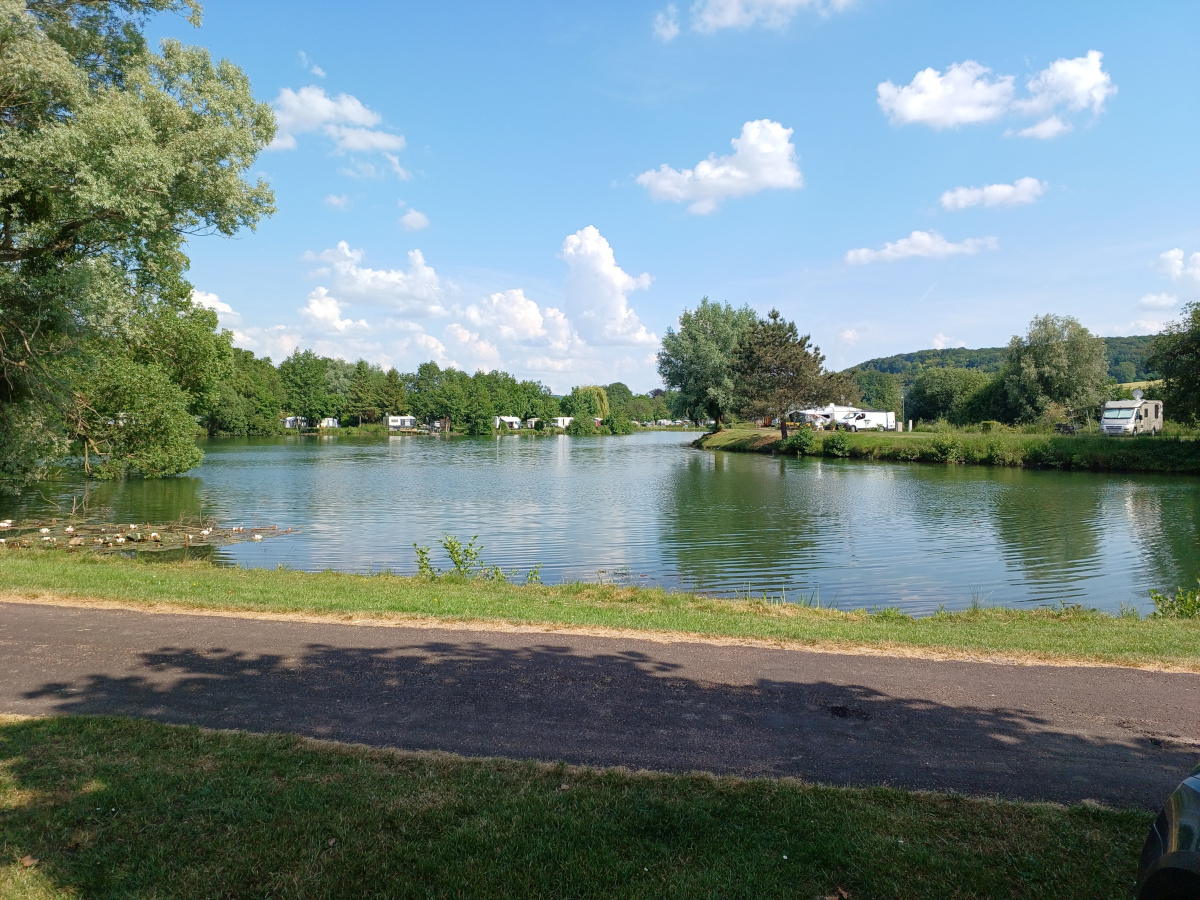
The next day we cycled along the route » Dieppe - it rained!

The route was much better than we had expected - mainly tarmac on old railway lines, and mostly extremely well signed.
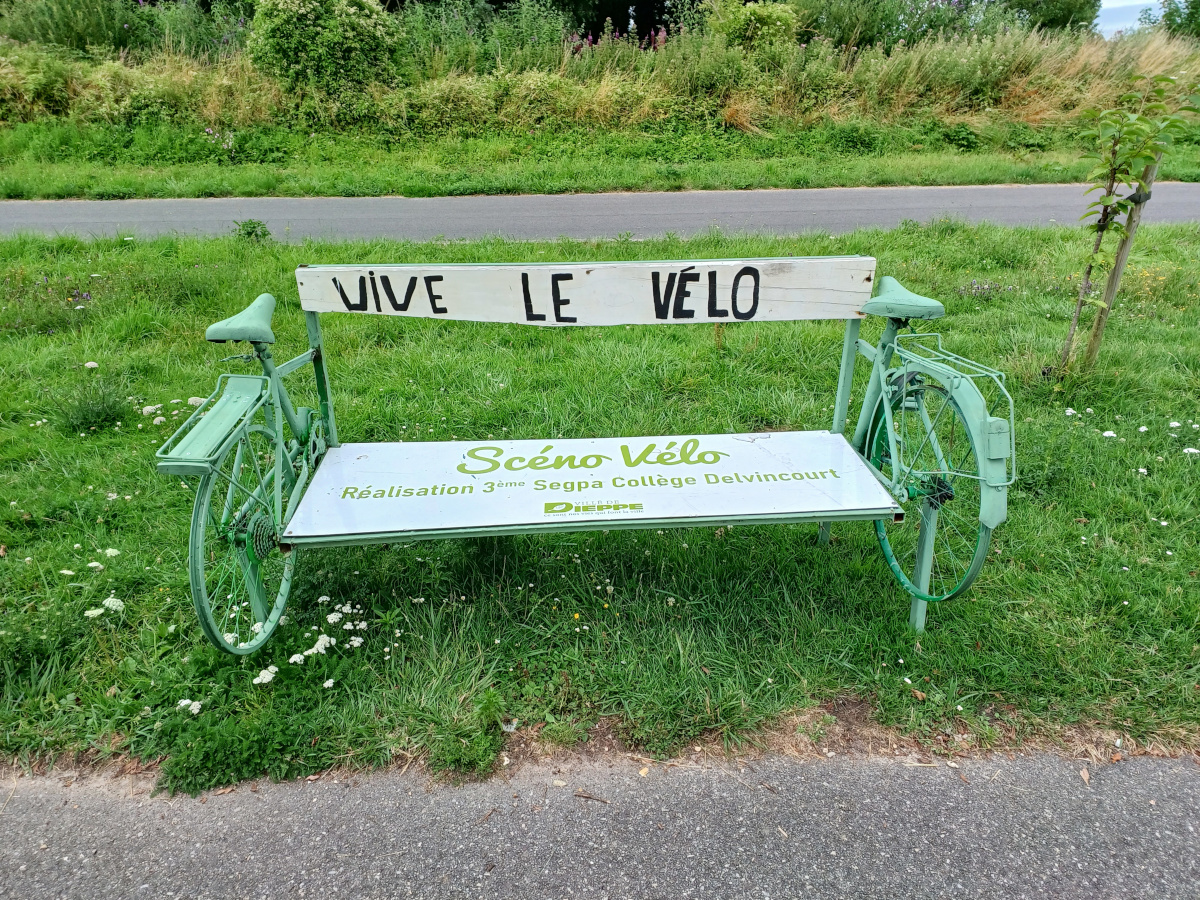
Dieppe harbour was good - nice seafood restaurant, and we were ready for some sightseeing again. But….. Just when you think everything is going well, life springs another surprise.
Daphne stopped at a junction, put her foot down, and her foot slid away from her on loose gravel. She crashed to the ground with the bike landing across her lower leg. Ouch.. She gamely continued on, but we could see she was in pain. That evening I drove her to the hospital - not broken, but very badly bruised. You will need a compression sock for some weeks, and you will need painkillers We need to praise the French Hospital staff, as they were very helpful & efficient - they were also very patient with our halting pigeon French - Thank you.
Maisons Laffitte & the start / finish of the Avenue Verte
An easy drive from Dieppe, and on the banks of the river Seine our campsite at Maisons Laffitte had all the facilities we needed, and was ideal for Daphne, who was finding any kind of exercise difficult and painful. It’s train station was ideal for a day trip into the centre of Paris.

We spent several days exploring the local area, and Daphne’s leg improved a little. The cafe’s and restaurants enjoyed our company, and we relaxed.
But Nick wanted to cycle in Paris! The round trip from the campsite along the Avenue Verte would be over 60 miles, and the electric trike had about that as a range - it was possible, just. Oh, and the weather had turned hot, in fact very hot, with temperatures of over 30 degrees centigrade.
Nick setoff at 5am, with two full water bottles, plus a 2 litre water container in his back pack. Once over the river, the route was really enjoyable - mainly along a track close to the river, with plenty of trees providing shade. Navigation was easy, Nick had downloaded all of the .gpx tracks available for the route and loaded them into his old faithful Garmin Edge Touring, which was happily telling him about every upcoming turning, and lighting up at every feature. But then the roads became busier, and the route more complicated. The electric trike is good, and comfortable, but light it is not. Picking it up is possible, but carrying it any distance is not. This isn’t a good thing to find on the route…. »
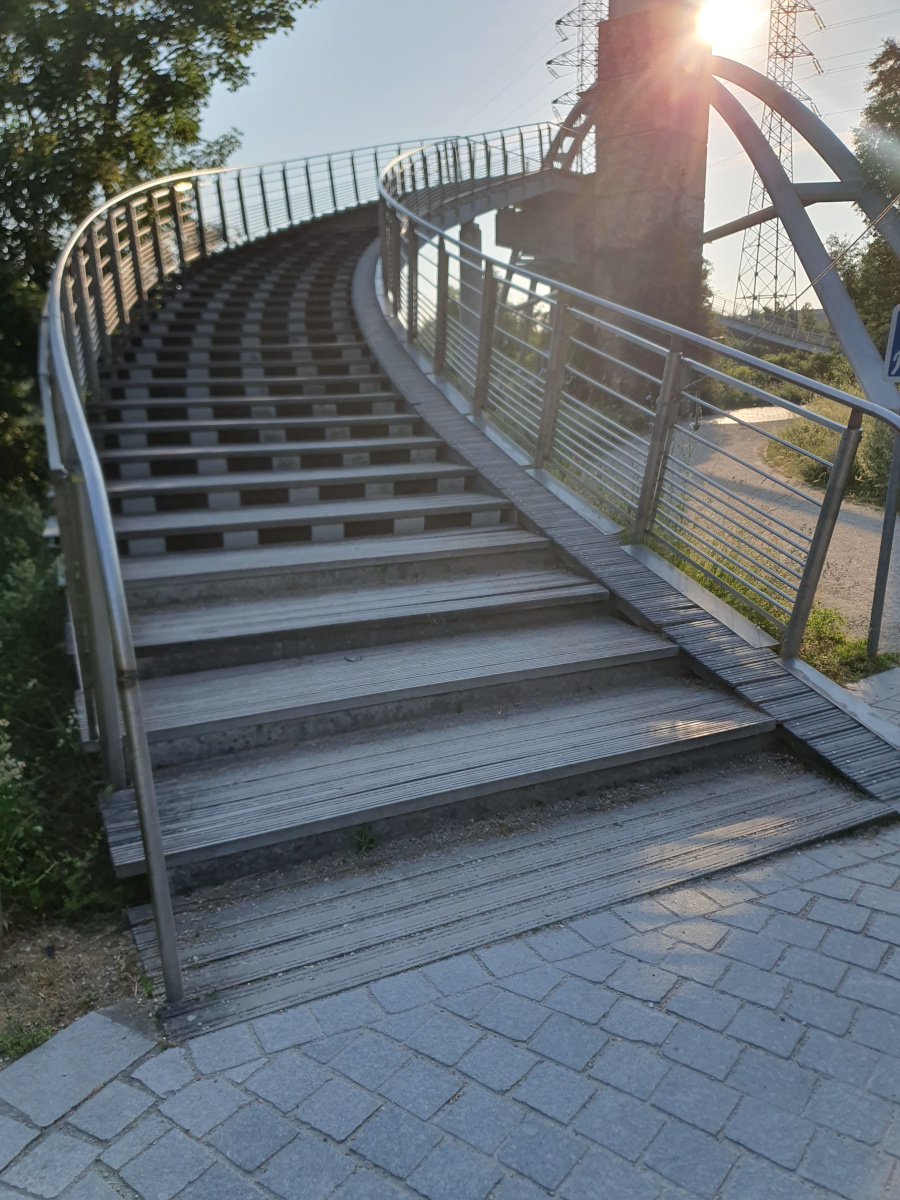
The little ramp at the edge of the steps is great if you have a two wheeled bike, but no good at all for a trike. Time to study the garmin, and maps. The old garmin was showing several cycle routes in the area, and it looked as if there would be a fairly easy detour around the bridge to get back onto the route. Oh, and there was a very clean public toilet nearby, which was handy because Nick was so worried about getting dehydrated in the heat that he needed a loo! After a short break for planning Nick setoff into the early morning rush hour traffic with the Garmin suggesting a route - but this didn’t go well. Each time he left the route the Garmin would recalculate, and dealing with traffic in a foreign land meant frequent stops to try to work out where to go. After 30 minutes of constantly having to recalculate the Garmin decided it was going to stop playing, and just continually display ‘recalculating’. Never mind, the phone has a very good mapping system on it - it’s just that you can’t easily use it whilst cycling. Pick a direction, cycle for 10 minutes, and then check on progress on the phone. Things were not going to plan, and it took a long time to get over this little hiccup. Plan ‘B’ emerged - just head for the centre of Paris, using any cycle lanes you can find (The Avenue Verte seemed to have vanished completely by this time).

There is a sort of peripherique of small roads each with a cycleway aroung L’Arc de Triomphe, and this avoided the frightening prospect of joining the traffic around the monument itself. From there, it’s all downhill to the centre of Paris, and the start of the Avenue Verte next to Notre Dame.
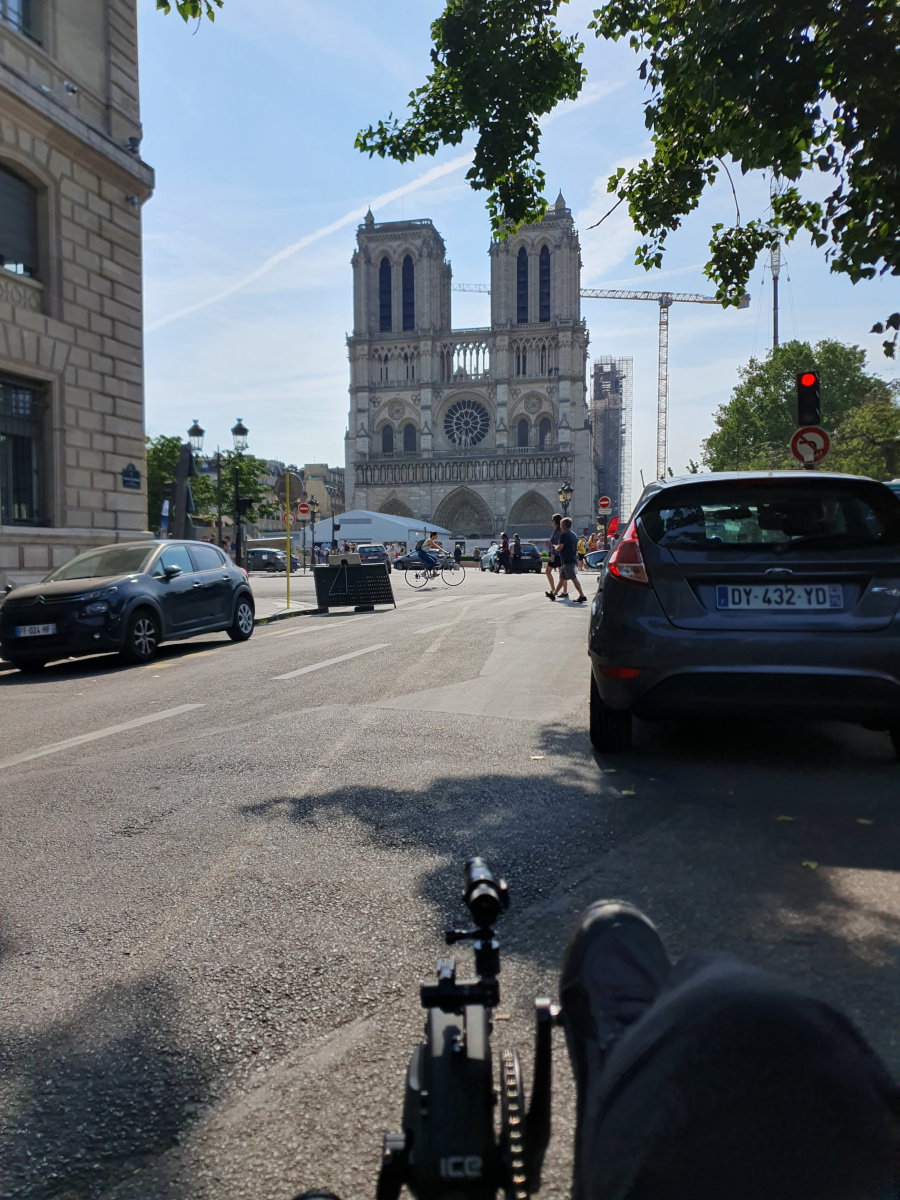
Notre Dame suffered severe damage from a fire some time ago, and is still undergoing repairs - Nick was very pleased to see that progress is being made on its restoration.
The old Garmin was turned off, given a few minutes rest, and then turned on again. The phone was consulted. Good, there were cycle routes But, there were many cycle routes, and on the phone and Garmin SatNav it was very difficult to see which one(s) were the Avenue Verte. There were road signs - everywhere, and there was traffic, and there were pedestrians, and there were other cyclists. In fact the other cyclists were one of the main problems - they were quick and Nick wasn’t. Revert to studying the phone, then cycling for a couple of minutes before studying the phone again. Slow progress, but soon Nick was onto the right route, and a small cafe beckoned - coffee and a bottle of water - oh, and a croissant. Things were looking up!
The route joined a canal, and according to the map it didn’t matter which side of the canal you were - nearly true, but navigating this sort of a problem is half the fun. There were a couple of places where roadworks signs diverted cyclists away from the original route, and a new route was being built - it all took time to navigate, and was very ‘stop start’, but it was good to see so many new cycle routes being constructed.
Nick was pleased with himself, as he had managed to mainly follow the Avenue Verte, and now he was next to the Seine again - but he knew that the bridge with all its stairs was ahead of him. After a study of the map he made a mental note of a road name where he needed to turn off of the route, and then follow his own diversion to get around the bridge. Plan ‘C’ was made, and then abandoned, as another diversion sent him away from the Seine, and there didn’t seem to be a way back again. Plan ‘D’ involved navigating to a point past the bridge, and back onto the route again. This meant cycling along a path next to a main road, but at least it was progress in the right direction.
Back at the nice clean public toilets, past the bridge, and back onto the route next to the Seine. The phone was nearly dead, displaying less than 5% battery remaining, and the Garmin was also warning of impending shutdown because of a dying battery. Still, navigation was not needed, as Nick now knew where to go. About 2 miles from the campsite the trike’s electric assist stopped working - flat battery, and progress slowed, but was still being made.
Nick made it back to the campsite almost exactly 12 hours after he left.

A very satisfying days ride, and the first time of riding so far that the electric assist packed up. This seemed to be mainly caused by the constant stop-start. On a flat road without navigation problems Nick normally rattles along at between 15mph & 17mph, which means that the electric assist is hardly being used, and the range extends to over 90 miles - this was not the case today.
Another thing to emerge from the day, was Nick’s realisation that a better method of navigation was needed. The Garmin is good, in fact he has several old different one’s and they are all good, but they can only display the mapping data they are loaded with. In Paris, and other large towns or cities there are now numerous cycle routes, and the problem is more a case of trying to find out which is the ‘right’ cycle route - in this case the Avenue Verte. Nick has created Garmin compatible maps from OpenStreetMap data before, and an idea was emerging - please see the Garmin-Maps section of this site.

















